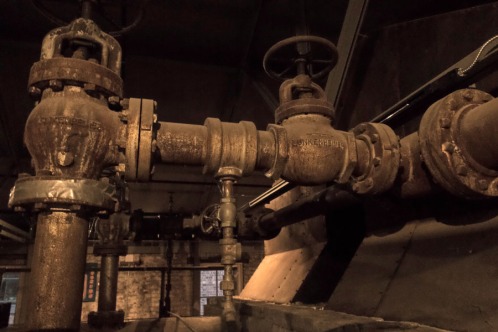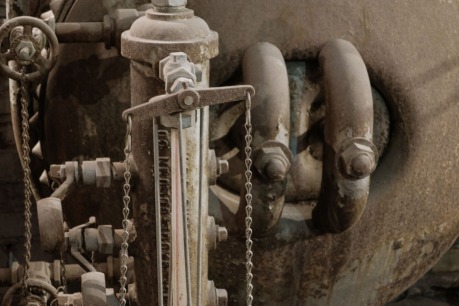
As a historian and a photographer I like to photograph historic sites, broadly defined. So when I discovered that the opening of a photography exhibit to which I was invited was being held in an old, restored mill in Kingston, New York, I slung my Canon G9X around my neck on the way out the door, figuring that at least I might get an interesting shot of the building’s exterior.
Kingston, in the mid Hudson Valley, is rapidly garnering a reputation as a major artistic center. Artists are flocking there to live and to work. In 2013 an organization called the Rural Ulster Preservation Company (RUPCO) purchased a now abandoned historic building (built 1903) that originally housed the United States Lace Curtain Mill and transformed it into a center with apartments and studio space for artists as well as, on the ground floor, space for exhibitions.
As expected, the exterior was worth photographing, and I lined everything up and got the image I wanted before going inside to see the exhibition I had come for. A friend I was with drew my attention to a little corridor and suggested I might find it interesting. Anticipating more artwork, I was instead surprised to note that some of the machinery that had once been used to operate the mill was still there, in its original place. Another reason I’m glad I brought my camera! Who could resist that? And I was in good company.
Here are some of the photographs I took along with descriptions of how I processed them. First, the one at the top of the page: This is the only interior shot that I took with the camera’s straightforward settings (as opposed to artistic or “scenic” presets). The very low light level required an ISO of 1600, so the first thing I did was to get rid of the noise using Nik Dfine. I then took the image into Nik Viveza, which I always find is a powerful tool for making selective adjustments accurately and fairly quickly. Since the color came out too warm I decreased the saturation to -35, and in order to maintain definition I upped the contrast to 10 (always remembering Rick Sammon’s dictum “Shadows are your friends”) and gave the structure an ever so slight bump to 2.

Those of you who know my work are probably wondering why I didn’t go for one of my “modern vintage” looks in the photo of the building’s exterior, possibly sepia or B&W. I tried it many different ways but didn’t like the results. The brickwork made for too much detail, and thus a monochrome looked confusing. You’ll notice the image is virtually square; because of the time of day, the setting sun threw the side of the building into bright, warm sunlight and the front into shadow. Regardless of what I tried, the only solution was to crop most of the building’s side out of the photo. (Reminder to self: Return with camera on an overcast day. That way the front and the side will better integrate with each other.)

The other machinery photos were all taken with the camera’s “Nostalgic” scenic preset. This obviated the need for a high and noisy ISO, but it did result in a somewhat soft, well, nostalgic look. In the one above the processing was simple: In Lightroom, again wanting increased definition, I bumped the contrast up to 24 and the clarity to 21. Then I took the saturation down to -17 for a look approaching monochrome but not quite getting there. In Photoshop I used Viveza to increase the structure on the little horizontal bar that has a chain on each end.

Finally, attracted by the pattern cast by the shadow, I made an abstract (above). Wanting increased definition, in Lightroom I bumped the contrast up to 21, darkened the shadows to -38, and slid the clarity up to 19. In Photoshop I used Viveza to decrease the saturation and to increase the structure on the main object in the picture (sorry — I’m a photographer not an engineer, so I have no idea what any of these things are called except “thingamajig”).
That was an interesting day out. Thanks to the friends who invited me to the show, and to RUPCO for breathing new life into a century-old building in midtown Kingston.